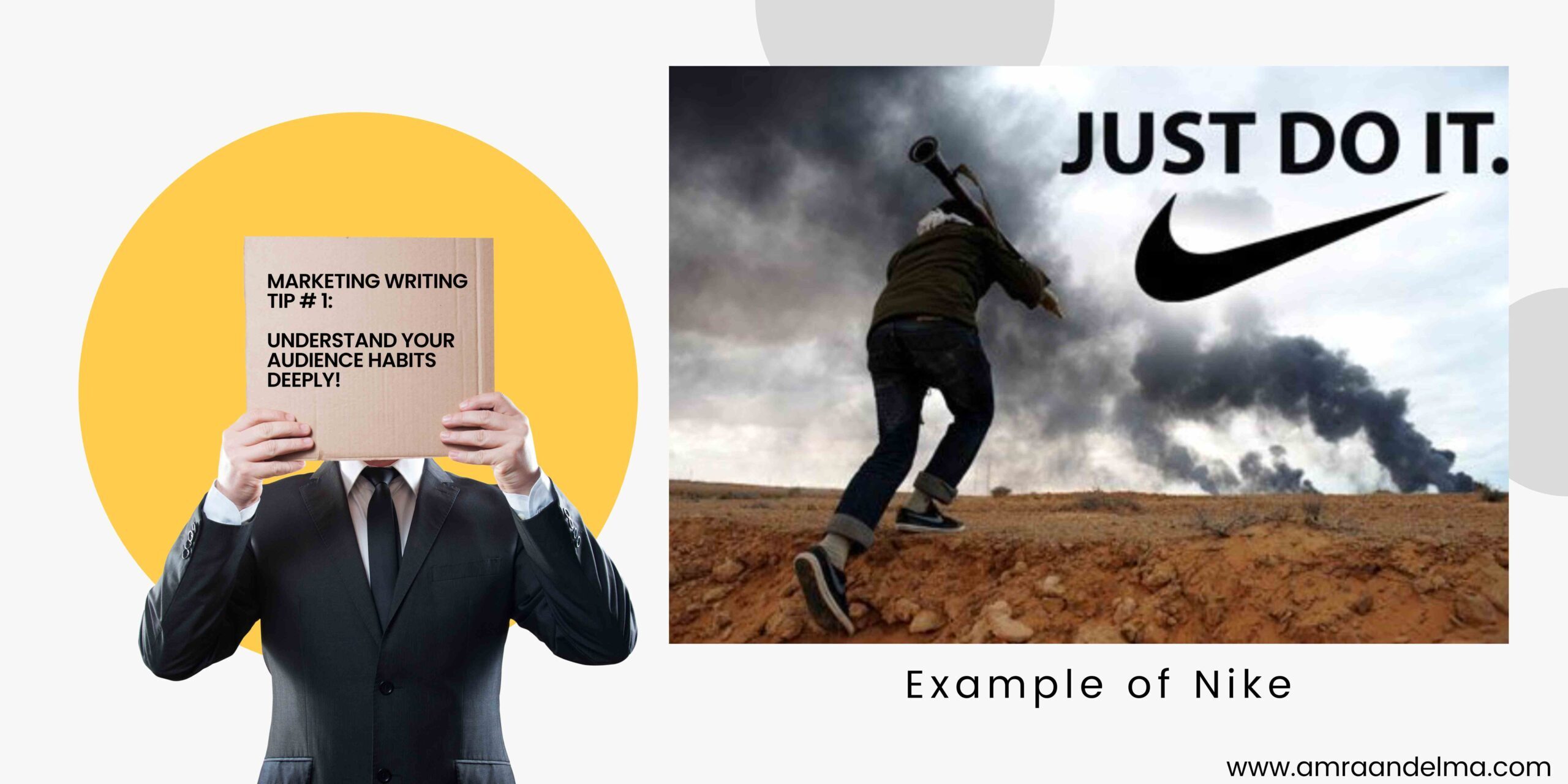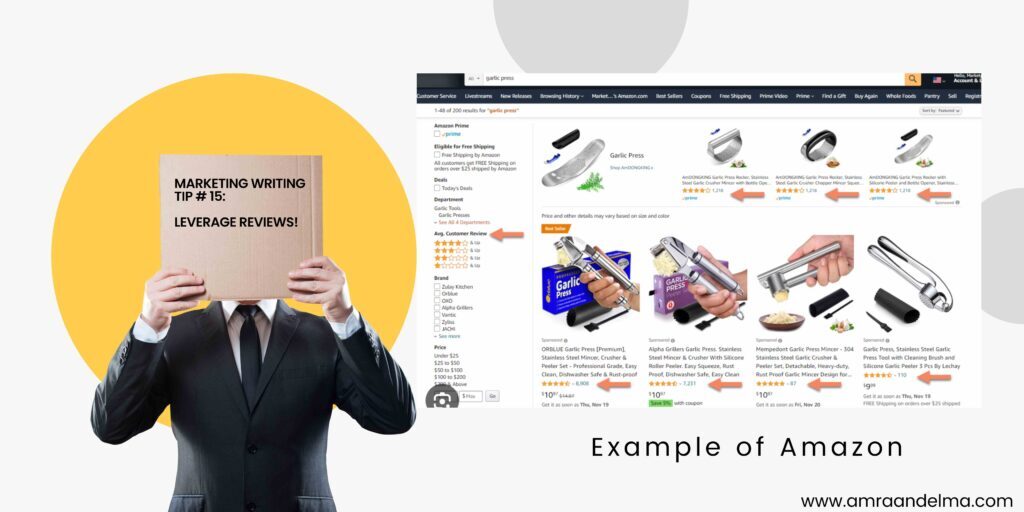
18 Dec MARKETING WRITING
Ever scroll through the back of a cereal box, skimmed through a travel blog post, or tapped through an Instagram ad? Congratulations, you’ve entered the whirlwind world of marketing writing.
It’s the art that lurks behind the words on a cereal box, the guidance in those travel blog tips, and the story whispered through that Insta ad. But here’s the twist—there’s a canyon-wide gap between the magnetic writing that pulls you in, makes you feel understood, and the bland, blink-and-miss-it content. That gap? It all boils down to the wizardry behind the words, the craftsmanship that separates the captivating from the utterly forgettable.
Below, we at Amra & Elma have compiled a comprehensive guide to marketing writing in 2024 and 30 distinct ways to help improve your writing skills to create a more compelling marketing content.
Marketing Writing in 2024 (Editors Choice):
- Marketing Writing Tip # 1: Understand your audience habits DEEPLY!
- Marketing Writing Tip #2: Be precise yet entertaining!
- Marketing Writing Tip #3: Support claims with facts so it doesn’t look like pure exaggeration!
- Marketing Writing Tip #4: Avoid copy-pasting AI written content – people can tell!
- Marketing Writing Tip #5: Infuse urgency to act NOW by limiting availability of “the mouthwatering deal.”
Marketing Writing – 15 Ways to Improve Your Marketing Writing Skills
Let’s dive into different writing styles that form the backbone of marketing communication. From the art of persuasion that drives action to the informative guides that solve problems, marketing writing includes a spectrum of styles, each having a different type of impact. Persuasive writing, the master of influence, includes catchy slogans and compelling calls to action, while educational writing empowers readers with knowledge through detailed guides and tutorials. Narrative writing, or storytelling, includes exciting stories that drive emotional connections, and descriptive writing, delivers vivid imagery in product descriptions and catalogs. Together, these four styles shape the landscape of marketing writing, catering to varied audience and different brand communication goals.
4 Types of Marketing Writing
1. Persuasive Writing:
This form of marketing writing aims to sway opinions, nudge decisions, and prompt action. It’s the backbone of compelling advertisements, captivating sales pitches, and convincing call-to-action statements. Consider those persuasive Facebook ads urging you to ‘Buy Now’ or the enticing slogans in commercials like Nike’s “Just Do It.” These examples leverage persuasive writing to influence consumer behavior.
2. Educational Writing:
Found in informative blog posts, how-to guides, and tutorials, educational writing seeks to provide knowledge and solve problems. Think of comprehensive product guides that explain features, or in-depth blog posts detailing step-by-step processes. Platforms like HubSpot and Moz often use educational writing in their content, offering detailed guides on digital marketing strategies and SEO techniques.
3. Narrative Writing:
This style of writing thrives on storytelling, devising engaging narratives to create emotional connections. It’s common in brand origin stories like the tale of Airbnb founders’ early struggles or the heartwarming stories behind Coca-Cola’s iconic Christmas ads. Narrative writing goes beyond mere product features; it paints a vivid picture that resonates with audiences on a deeper level.
4. Descriptive Writing
Often seen in product descriptions, catalogs, and sensory-rich content, descriptive writing aims to create vivid imagery and sensory experiences in the reader’s mind. Take luxury fashion brand websites that use descriptive writing to evoke sensations and emotions – consider a brand like Chanel. Their descriptions for fashion items, such as a classic handbag or an elegant evening gown, are crafted with meticulous attention to detail.
For example, a product description for a Chanel handbag might immerse the reader in a world of “sophistication.” It might highlight the exquisite craftsmanship, describing the supple texture of the leather, the precise stitching that exudes finesse, and the gleaming, and signature hardware. The description might evoke sensations of opulence, describing the bag as a timeless piece that transcends trends, and embodying the essence of refined taste and luxury. Through descriptive writing, Chanel creates an experience beyond a mere fashion item, inviting the audience into a world “exclusivity.”
Each of these writing styles in marketing serves a distinct purpose, catering to diverse audience needs and preferences.
Marketing Writing Tip #1: Understand Your Audience
Effective marketing writing is based on understanding your audience’s desires, pain points, and aspirations. By diving into their world, you can tailor your message to deeply resonate with their needs, crafting content that feels genuine and moves emotions.
Nike’s “Just Do It” campaign serves as a great example—it wasn’t just about athletes but about everyone striving for motivation and resilience in the face of adversity. It spoke to the moments when you felt your back was against the wall, aiming to uplift and empower. By aligning with the audience’s aspirations for personal growth, Nike evolved beyond sportswear, solidifying itself as a lifestyle brand ingrained in the fabric of personal improvement, transformation, and growth.

Marketing Writing Tip #2: Be Concise
In today’s fast-paced world, staying brief wins the attention of the audience that is often overwhelmed with the sheer amount of available content. Five seconds—that’s the blink of an eye you have to capture attention. Less is often more; concise sentences pack a punch, keeping your audience engaged without overwhelming them.
Twitter’s adoption of a 280-character limit stems from the platform’s aim to foster succinct yet meaningful conversations. Originally restricted to 140 characters, the expansion to 280 characters was introduced to provide users with more room for expression while still encouraging brevity. By limiting the character count, Twitter compelled users to distill complex thoughts into concise, easily digestible snippets. This constraint nudges users to be more creative and strategic with their language, conveying thoughts effectively within a confined space.
According to https://papersowl.com/, an essay writing brand, precision in language forces us to communicate complicated ideas in simple terms. Furthermore, constraint on limit of words or characters further pushes our ability to focus on what matters by focusing on communicating compelling ideas in a sometimes very entertaining way.

Marketing Writing Tip #4: Add a Time Element
Add a time element: Infomercials mastered this with limited-time offers. Think “Black Friday deals for 24 hours only.” A sense of urgency spurs action, urging your audience to act swiftly. Just as limited-time offers create urgency, compelling immediate action, Amazon employs limited-time lightning deals to prompt quick purchases, capitalizing on the urgency factor to drive immediate decisions from consumers. This time-bound approach triggers a fear of missing out (FOMO) and encourages customers to make rapid buying choices.
Below is an example of an ad that urge consumers to purchase vs a more passive ad:
A) Ad with Urgency:
“Flash Sale! 24 Hours Only – Get 50% Off All Dresses. Shop Now!”
This type of ad, often seen on e-commerce platforms or retail websites, creates urgency by highlighting a limited-time offer with a clear call to action. By using phrases like “Flash Sale,” “24 Hours Only,” and “Shop Now,” the ad prompts immediate action from potential customers, encouraging them to take advantage of the significant discount within the specified timeframe.
B) Ad with no Urgency:
“Check out our latest collection. Great deals available. Explore our products and find something you love!”
In the first ad, urgency is emphasized with phrases like “Act now,” “Limited time offer,” and “Offer ends tonight,” creating a sense of immediacy. The urgency encourages customers to make a swift decision to take advantage of the offer. On the other hand, the second ad lacks a strong call to immediate action, providing information but not urging the audience to act right away.
Marketing Writing Tip #5: Utilize Active Voice
Active voice infuses confidence and clarity into your message. Bold declarations like “We guarantee results” resonate more than passive constructions such as “Results are guaranteed by us.” For instance, Red Bull’s slogan, “Red Bull gives you wings,” employs active voice, asserting energy-boosting benefits with unwavering confidence, leaving no room for ambiguity. This active, assertive tone propels the message forward, captivating the audience’s attention and fostering a stronger connection with the brand’s promise.
Marketing Writing Tip #6: Be Honest and Vulnerable
Sharing personal stories of triumph and adversity, especially how a product made an impact, fosters authenticity. It establishes a genuine connection, resonating with the audience’s own experiences. Patagonia’s transparency in discussing environmental challenges showcases its authenticity. The brand’s commitment to sustainability isn’t just a marketing ploy but a deeply ingrained value. By openly addressing its challenges and triumphs, Patagonia forges a deeper connection with its audience, aligning values and creating a community around shared beliefs and aspirations.

Marketing Writing Tip #7: Use Descriptive Adjectives
Painting a vivid picture with descriptive language elevates your product or service. When your audience can almost feel, smell, or taste its essence, it becomes irresistibly enticing. Starbucks excels in descriptive writing, portraying its beverages as indulgent treats—words like “velvety,” “rich,” and “aromatic” elevate the experience beyond mere coffee. This descriptive skill immerses the audience in an experience, heightening the appeal and allure of the product or service being offered.
Marketing Writing Tip #8: Set Clear Call-to-Action
Direct and unambiguous guidance leads your audience toward the desired action. Whether it’s a form submission or an “Add to Cart” button, simplicity prompts action. Airbnb’s call-to-action buttons are straightforward, guiding users with clear prompts like “Book Now.” This straightforward approach simplifies the user journey, reducing friction and encouraging immediate action, ultimately enhancing the likelihood of conversion.
Marketing Writing Tip #9: Stay Original
Embracing your unique angle and conveying your advantage right from the start sets you apart. Originality stands out amidst the sea of content, capturing attention instantly. Dollar Shave Club disrupted the shaving industry with its original approach, injecting humor into its marketing to differentiate itself from traditional razor companies. This distinctiveness not only garners attention but also creates a lasting impression, drawing in an audience seeking something different and refreshing.
Marketing Writing Tip #10: Stay Memorable
Consider what sticks with you—the originality, the authenticity, or even the emotional impact. Use these elements to communicate, leaving a lasting impression on your audience. Coca-Cola’s emotional storytelling remains etched in memory through campaigns like “Share a Coke” and the iconic polar bear ads. This emotional connection fosters a deeper bond with consumers, making the brand unforgettable and maintaining a significant presence in their minds long after the ad has ended.
Marketing Writing Tip #11: Avoid Offense
Inclusivity matters. Steer clear of controversial topics, political or religious references that might alienate segments of your audience. Pepsi’s controversial ad featuring Kendall Jenner faced backlash for trivializing social activism. This misstep highlights the importance of thorough vetting and understanding diverse perspectives before delving into sensitive topics in marketing campaigns. Staying neutral and inclusive prevents potential offense, ensuring your message resonates positively with a broader audience.
Marketing Writing Tip #12: Solve a Problem
Addressing challenges or offering solutions resonates deeply with your audience. Think of TikTok’s viral hacks that solve everyday problems. Marketing hot rollers to resolve flat hair issues is a prime example of addressing a concern of fine hair or flat hair individuals. By presenting solutions to real problems, your marketing message becomes valuable, tapping into genuine needs and sparking interest among your audience.
Marketing Writing Tip #13: Write for Humans
Authenticity and relatability matter! While AI can spark ideas, infusing your humanity into the writing forges real connections. Brands like Apple craft their messages to resonate with human emotions rather than solely relying on technical specifications. This approach establishes a connection beyond features, appealing to the emotional and practical needs of their audience, fostering a deeper engagement.
Marketing Writing Tip #14: Evoke Emotion
Moments of genuine emotion resonate deeply with your audience. Consider capturing these moments in your content. For instance, a customer’s surprise and joy when trying a foundation for the first time and discovering its ability to cover hyper-pigmentation can evoke powerful emotions. Brands that tap into these moments, like in testimonials or user-generated content, convey authenticity and create a memorable impact that lingers in the minds of their audience.
Consider the difference in two below:
Ad Evoking Emotion:
Ad 1:
“Join us on a journey of self transformation. Our new line of products isn’t just about skincare; it’s about self-care. Experience the freedom of not covering your skin anymore! Nurture yourself with healthy products that make you feel secure about what you put on and ultimately into your body! ”
Ad Without Emotion:
Ad 2:
“Introducing our latest skincare line. Our products are designed to improve skin and bring radiance. Try our new line today and see the difference!”
In Ad 1, the focus is on evoking emotions by connecting the product to feelings of freedom, health, and self-worth. It uses emotive language and focuses on the emotional benefits of using the product, aiming to create a connection with the audience. On the other hand, Ad 2 is straightforward, focusing on the functional aspects of the product without attempting to evoke any emotion.
Marketing Writing Tip #15: Leverage Reviews
Testimonials and reviews hold immense power. Incorporating authentic feedback into your marketing copy offers social proof, enhancing trust and credibility. Think of platforms like Amazon utilizing customer reviews as content, showcasing real experiences and opinions to reinforce the value and reliability of products. Utilizing these reviews bolsters confidence in potential customers, influencing their purchasing decisions positively.
Below are example of the difference a review strategy can have:
A) Without review strategy:
“Introducing our new skincare line! Our products are formulated with premium ingredients to give you radiant skin. Try it today!”
B) With review strategy:
“Discover why our skincare has gone viral on social! ‘This moisturizer is a game-changer,’ says @influencer. ‘My skin feels supple, even, and glowy all day!’ @influencer2.
In the second example, the ad leverages real customer or influencer feedback (‘game-changer,’ ‘supple and even’) to create social proof and entice potential buyers. This strategy uses authentic testimonials to build trust and credibility, making the product more appealing and encouraging prospective customers to try it based on the positive experiences shared by influencers and other social media users.

Marketing Writing – In Conclusion
In the diverse landscape of marketing, mastering these 15 strategies forms the bedrock of impactful content creation. Understanding your audience deeply, weaving concise yet compelling narratives, and substantiating claims with factual evidence stand as pillars of trust and engagement. Employing urgency, authenticity, and emotional resonance crafts memorable experiences, while steering clear of offense and solving real problems solidifies connections. Authenticity, emotional appeal, and leveraging reviews become the threads that weave a tapestry of trust and influence. By embracing these strategies, marketers navigate the dynamic realm of content creation, leaving lasting impressions and fostering enduring relationships with their audiences.
MARKETING WRITING 2024 – FAQ:
What writing do you do in marketing?
In marketing, writing encompasses a diverse range of content creation tailored to engage and persuade audiences. It involves crafting compelling copy for advertisements, creating engaging social media posts, developing informative blog articles, drafting persuasive email campaigns, scripting attention-grabbing video content, and curating captivating website copy. From attention-grabbing headlines to compelling storytelling, the writing in marketing aims to resonate with the target audience, convey brand messages effectively, and drive desired actions, ultimately contributing to brand awareness, engagement, and conversions across various platforms and mediums.
What does a marketing writer do?
A marketing writer crafts persuasive and engaging content designed to captivate audiences, drive brand awareness, and encourage action. They meticulously research and understand the target audience, translating complex ideas into accessible language, and employing various tones and styles to resonate with diverse demographics. From compelling ad copy and gripping social media posts to informative blog articles and email campaigns, a marketing writer tailors their messaging to align with brand objectives, leveraging storytelling, creativity, and strategic language to evoke emotions, build connections, and ultimately compel readers to take desired actions, be it making a purchase, signing up, or engaging further with the brand.
What is marketing writing called?
Marketing writing is often referred to as “copywriting.” This specialized form of writing focuses on crafting persuasive and compelling content aimed at promoting products, services, or ideas. Copywriting involves creating various types of content across different platforms to engage audiences, build brand awareness, and encourage specific actions such as making a purchase, signing up for a newsletter, or engaging with the brand further.
What is written marketing?
“Written marketing” generally refers to the textual content or written materials used in marketing strategies. It encompasses various forms of written communication designed to promote products, services, or brands. This includes content such as advertisements, website copy, blog posts, social media content, email marketing campaigns, brochures, press releases, and more. The goal of written marketing is to effectively communicate messages, engage the audience, build brand awareness, and ultimately drive desired actions or conversions.

